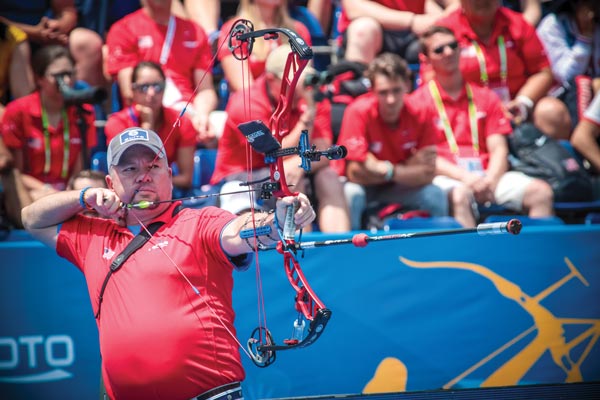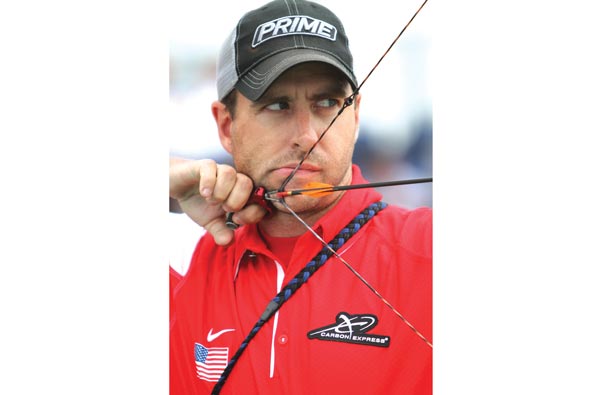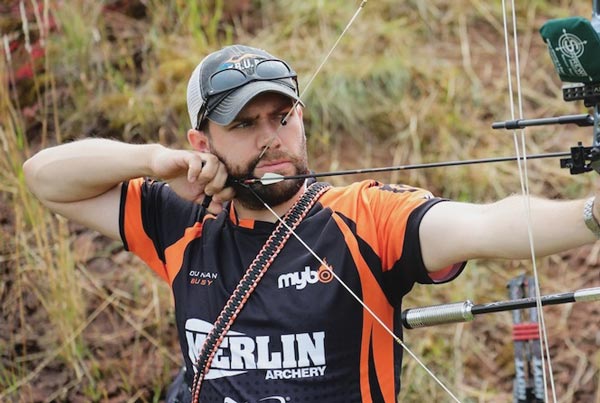Duncan Busby outlines the importance of a set of comfortable, consistent reference points, and explains how you can find what works for you

A solid and repeatable anchor point is essential to achieving consistent results
Your reference or anchor point is essential to consistency; the position to which you draw your string should be easily identifiable, comfortable and repeatable. A poor anchor point can not only affect your results at the target but it can impair your form and aim as well, so how do you achieve a consistent position?
First, we need to identify your reference point, or, more accurately, reference points; a simplified explanation is often described as where the archer’s hand meets their face at full draw. Though hand-to-face contact is a good starting point, this straightforward definition is better suited to traditional archers. Compounds use multiple reference points since the combination of sight, peep and release aid makes the aiming process slightly more complicated…
Release hand
The first point of reference and arguably the most important for a compound archer is the position of your release hand on your face. Depending on the type of release aid you use and the specific physiology of your face, your reference point can vary from those of other archers in a variety of ways. But wherever you choose to position your release, you should make sure that you can identify the exact part of your hand that contacts with a specific point on your face, jaw or neck.

Using a kisser button allows you to find a repeatable contact point on your mouth
In my experience archers using a wrist release will often choose to sit their hand a little further back, whereas hand-held release shooters will usually sit a little further forward, but your exact position is largely down to personal preference.
It’s important to remember that your draw length, D-loop and release aid will all help to determine the position of this first reference point, so you may find that your hand-to-face contact point will change depending on your equipment setup.
As a starting point I’d recommend trying to find a position that allows the first two knuckles of your hand to sit either side of your jaw bone, somewhere between the corner of your mouth and the back of your jaw; this position can then be modified to suit specific form or equipment preferences. Don’t forget it’s the consistent contact point that’s important here, not the exact position of your hand.
Nose to String
Contacting your string with your nose can help with consistency. Though it will not suit every archer as it largely depends on your draw length and the angle of your string, it is a point of contact you should strive to achieve.

Some archers favour a forward anchor
position when using a handheld release
An archer using a bow with a longer axle-to-axle length can find this reference point easier to achieve, as the shallow string angle can allow you to find a gentle point of contact without the need to crane your head forward. This is an especially difficult anchor point to achieve naturally and comfortably when you don’t fit your bow’s geometry, so those archers having to tilt their head or those using a shorter axle-to-axle bow with an acute string angle could try altering their draw length slightly in order to create this contact point, though this should not be done at the expense of form. And remember that any adjustment you make to your draw length may require a small change to the size of your D-loop in order to maintain the consistency of your release hand position, so try to keep this in mind when making
any changes.
String to Mouth
This is an often-overlooked anchor point as it can sometimes be difficult to identify without assistance, but once you are aware of the string’s position on your mouth you can use this to gain a little extra consistency. Ideally, the string should sit at the corner of your mouth at full draw, although its exact position can differ according to your axle length and draw length. If you are struggling to find this position each time I’d suggest using a kisser button – this needn’t be anything elaborate, just a simple ball of serving or a rubber nock will work fine. It should sit in a natural place, such as where the string touches your mouth, and you should be careful not to contort your face to find it as this will lead to inconsistencies. Kisser buttons aren’t for everyone though, and if you are struggling with this particular reference point concentrate on getting the others correct instead.
Peep Sight
Your peep sight position isn’t a physical point of contact, but it’s important in ensuring that your shot is consistent. Unfortunately most archers let their peep sight determine their shooting position, instead it should fit around your form; you should not be twisting, bending or otherwise contorting yourself around it. If you close your eyes at full draw, you should find that once you have made contact with your other reference points your peep should be properly aligned. If your reference points are consistent and your peep sight doesn’t line up with your eye at full draw, move it until it aligns perfectly every time – don’t be tempted to start adjusting your other anchor points to fit around it.

Not everyone will find the same reference points comfortable or even possible, so a little experimentation is sometimes required
Once you have established your reference points you should check that they are consistent and comfortable to shoot at a mid distance; this should allow you to shoot both shorter and longer distances without having to make adjustments to your form. If any of your reference points feel uncomfortable or if your peep fails to line up at this distance, make minor adjustments until you achieve a position you’re happy with.
Your release hand position may change slightly when shooting different distances as your peep will need to continue to align between your eye and the scope; sitting higher on your face at closer targets and lower when they’re further away. This is perfectly normal and is down to the angle of the bow, and it’s why it’s particularly important to set your peep height at a mid-range distance.
Your anchor points are the foundation to good shooting form, and without them your results are unlikely to be consistent, so it’s essential that you spend time finding a repeatable shooting position.
Not everyone will find the same reference points comfortable or even possible, so a little experimentation is sometimes required in order to find something that will work for you. But remember, having to move or contort yourself to fit your equipment is a sign something’s wrong, so don’t be afraid to make necessary changes to your equipment or form in order to find anchor points that are easy to identify, comfortable to shoot and, above all, natural to repeat.
This article originally appeared in the issue 111 of Bow International magazine. For more great content like this, subscribe today at our secure online store www.myfavouritemagazines.co.uk

